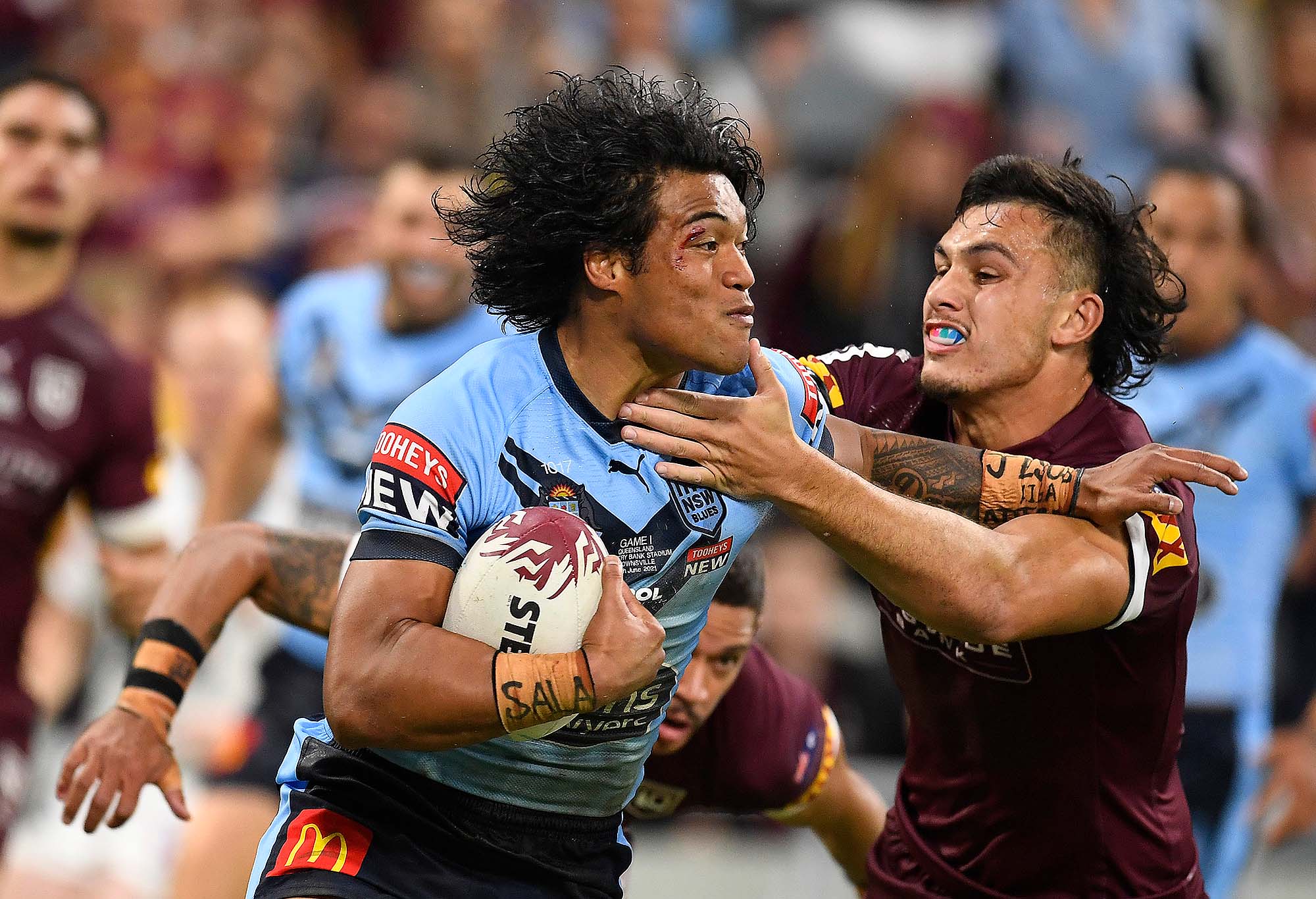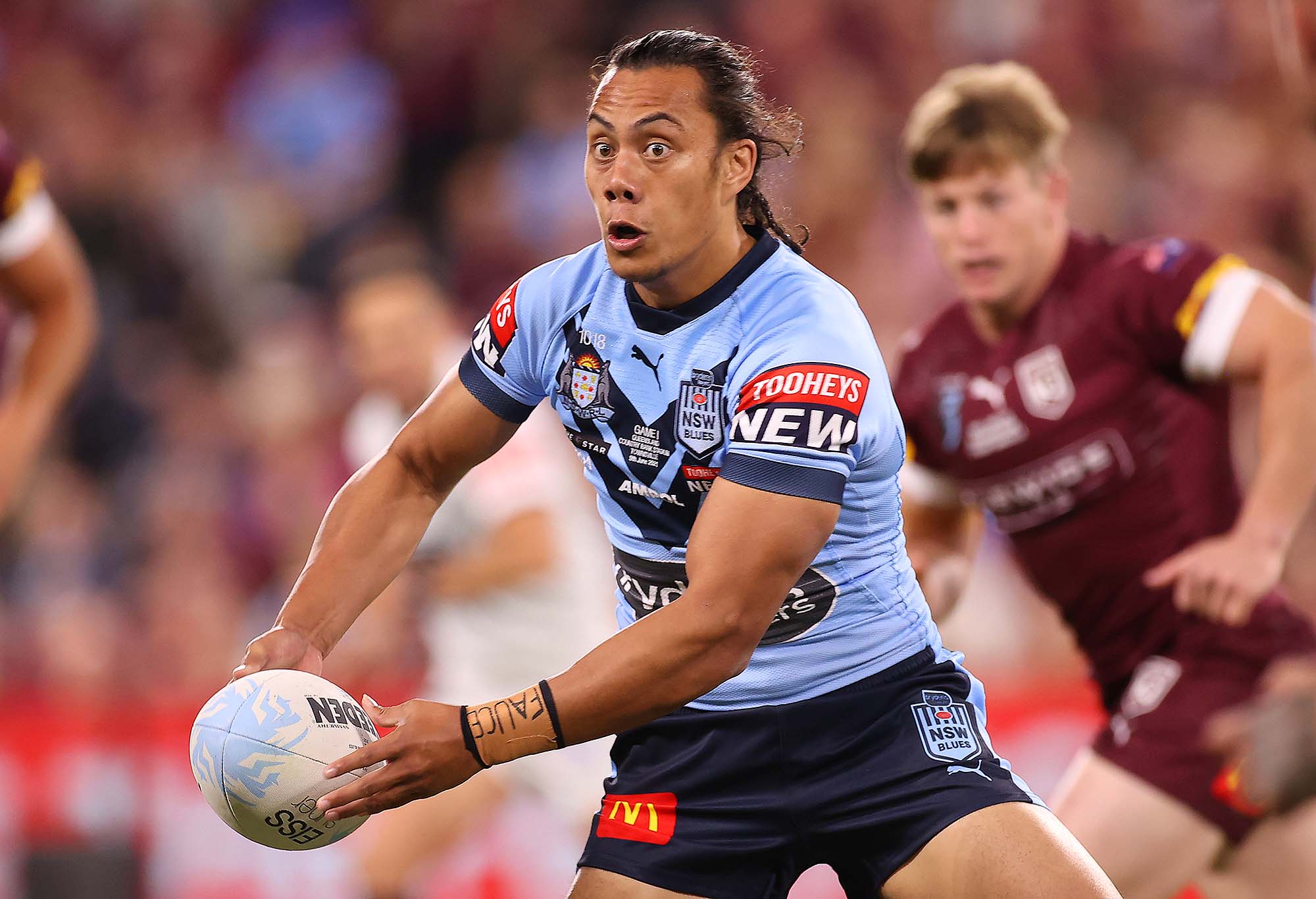It’s a tough job being favourites. As literally everyone will tell you when you dig deep into the numbers on Origin, the numbers have favoured NSW for many, many years and that has historically meant very little in the past.
This year again, the on-paper teams would suggest that the Blues are in a better position, and indeed, so do the bookies, with NSW $1.58 and Queensland $2.42 to win the first match-up on Wednesday.
Last year was a bash up, especially in game 1, and the Blues will be hoping for the same again. We’ve covered the Maroons – if you want to read how Queensland will win, it’s here – so let’s get into the three key areas for NSW to exploit.
Let the system replace the superstars
Reams have been written about how NSW have to replace the points lost due to the absences of Tom Trbojevic and Latrell Mitchell, who combined for 11 of 15 NSW tries last year.
I’m here to tell you two things: one, they don’t, and two, 2021 was nonsense. I’m not sure the form lines from last year are really relevant this year, because the rules are so different and both games were played under such unusual circumstances.
Let’s get to point 2 first. 2021 was an asterisk year for rugby league and even more asterisk for Origin.
The try count itself is a misnomer, because a lot of them were garbage time, blowout 2021 points that don’t matter. In normal times, Origin is a race to 20 points because whoever gets there wins.
So NSW do need to replace some tries, but not as many as 11 (and you could make the argument that Turbo lost points through defending badly in the front line, too).
Game 1 was a classic example of this: the stats would tell you that it was quite close, with the usual grinding stuff, except NSW managed to blow the game apart with 10 line breaks to one, resulting in a huge metres advantage.
NSW were able to showcase Turbo and Latrell after the break, when the game was over as a contest, but the points that they created when it was live were much more (for want of a better word) traditionally created.
The scintillating play that came from the two gun centres combining was only enacted when the game state allowed it – before that, it was more system-oriented play, much like it will be this time around.
What is a better form line is the form of Penrith versus everyone, because (as I have mentioned elsewhere) what we are going to be looking at is Panthers deluxe.
That brings us to our second point. Offensive production is a strange beast, because it is quite easy to look at 11 missing tries and wonder where they are going to come from.
Doubtless the attacking threat of Trbojevic and Mitchell does need to be replaced, but it is highly likely to be created in a systematic way, spread across the team.
If you’ve studied the Panthers at all, you’ll know that they run things through Isaah Yeo, with Nathan Cleary and Jarome Luai as the primary creative forces.
We won’t see the centres moving sides and linking up, as last year, but we will see the shape from the Panthers attempt to isolate outside backs against outside backs and cleave a line down the seam between inside and outside defence.
In practice: all four currently named centres across both sides are far, far better at attacking than defending, so NSW will seek to get their guys into battles with their opponents, notably Jack Wighton against Dane Gagai, a notably good ball runner against one of the NRL’s weakest defensive centres in 2022.
Yeo’s interplay with the backrowers comes into this too. Plenty of Penrith tries have come where the middle defenders meet the outside backs, and with Daly Cherry-Evans – never the best half defensively – likely to be positioned there, Fittler will want to see a lot of traffic thrown at him.
Of course, this system would work even better if the two missing players were there, but half of the point of attacking systems is to deliver the ball to where your individuals can shine: just this time, those individuals are different.

Brian To’o. (Photo by Ian Hitchcock/Getty Images)
Return and rest in yardage
Queensland’s resurgence in Game 3 last year involved a kicking strategy that took the ball away from Brian To’o and drastically reduced his ability to impact the game through set starts. His influence diminished game to game as the Maroons worked out how to limit his time on the ball.
The Blues need to make sure that To’o is able to come into the game, largely through his carries. One of the underreported aspects of the Panthers’ system has been their ability to perform what you might call ‘active rest’ in ball transitions.
When a long kick comes in, Penrith are so confident in the ability to To’o, Dylan Edwards and Taylan May to return the ball well on the first two plays that they rarely retreat the full distance, ensuring that the middles are able to either take plays three and four as hard carries and then create a better kicking opportunity or simply conserve energy for defending.
This is often how they win out over an extended period of ‘the grind’, as we like to refer to it: they rest up, then load up with the ball, then arc up in defence.
For what it’s worth, the Bulldogs were trying this too – something from Panthers former attacking guru coach – and even with their poor team, they did get, relative to roster strength and ladder position, quite good territory.
If, as you might expect from the success of the strategy in Game 3 2021, Queensland opt for either long kicks from dummy half, via Ben Hunt, or early tackle count kicks, then NSW need to make sure that they can react in yardage.
This is where To’o and Daniel Tupou come in. They are one and two in the NRL among wingers for runs over 8m, partly a recognition of where they pick the ball up compared to other teams, but also of their ability to get good starts.
They’re also 3rd and 11th respectively across all positions for post-contact metres, showing just how effective they are at winning play the balls when they take their runs.
The wingers have been much talked about in their ability – or otherwise – to defend kicks, but this is the key area in which they can aid the defence via their attack.
Strong carries inch the game further away from their own line, thus reducing the ability to Queensland to enact the much-rumoured policy of kicking to To’o and taking advantage of his relative lack of height.
The Broncos, for example, have the least tackles inside 20m but the second-highest number of weighted kicks, the stat for the kick that you think of when you think of Selwyn Cobbo above a winger to score.
Whenever they get there, they invariably attempt it, and you can expect the same from Queensland with Cherry-Evans a master of that kick.
The best defence against that tactic is to move the whole game further up the field and make life more difficult for the kicker to enact that move. It’s hard to make that play from anywhere outside of the 20m zone.
If To’o and Tupou can win the backfield, they’ll allow their forward to be fresh enough to have the line speed to keep Queensland far from the line, removing that kick from the arsenal. Watch out for that ‘active rest’ idea come Wednesday night.

(Photo by Mark Kolbe/Getty Images)
Murray and Matterson can link inside and out
We’ve spoken a lot about the Panthers’ middle service system and how Yeo is at the heart of the attack. That’s undoubtedly going to the be the case for the Blues this time as well, with Brad Fittler unlikely to move away from that as a Plan A.
Where he might have a Plan B is in the second phase play. In this, we can refer to both club football and to last year, because there’s lessons in both.
The next best exponent of the Isaah Yeo role in the NRL is also playing for the Blues, in the form of Cameron Murray, and if you watch back some of the best attacking play from 2021, he was central to it.
Last year, the middle service was there but not to the same extent, largely because Yeo was newer to Origin and Penrith themselves had not yet evolved to where they are now.
What we saw was Yeo in the middle and Murray in the back row using their ball-playing abilities to engage the line and find their centres – it was half of the reason why Trbojevic and Mitchell were so effective, because they were given the opportunity by strong service.
Cleary and Luai also made several breaks through the defensive seam between inner and outer, while on other occasions, they went through hands all the way to Josh Addo-Carr to scoot along the touchline. Often, Murray was the one on the right edge getting the ball to Turbo and Foxx.
As regular readers to The Roar will know, I love the ‘try contributions’ stat, which awards play before the try or line break assist: Murray absolutely kills it at this stat, as indeed, he does for line break assists and total try involvements.
Right up there with him, unsurprisingly, is Yeo, but also not far behind is Ryan Matterson. In fact, if you’re looking a pure ball-playing forwards, then NSW can boast the top five, with Yeo, Murray, Matterson named, Victor Radley injured and Jake Trbojevic not required.
The threat of Murray on one edge and, if Fittler uses him as a replacement for Tariq Sims, Matterson on the other, could be vital to how the attack transitions from inside to out.
Matterson and Junior Paulo are among the best in the NRL at generating and exploiting second phase play, with huge offloading skills allied to an ability to spread quickly against unset defence. If you were wondering why Dylan Brown has gone so well in 2022, there’s a decent chunk of it. Now imagine Wighton or Staggs in the Brown role.
My suspicion will be that Sims and Liam Martin will be used to offer inside runs and punch into the line, while Matterson will be encouraged to offload and Murray to ball play.
It will be interesting to see how Fittler uses Murray and Matterson: if he goes for both at the same time, then the potential for fast spreads and rapid lateral ball movement are high, but he might opt to keep one running back rower on at a time, with Matterson replacing Sims and Martin for Murray.
Either way, it would make a whole lot of sense to play more expansively and make the most of three superb ball-players in the back row.






























































































